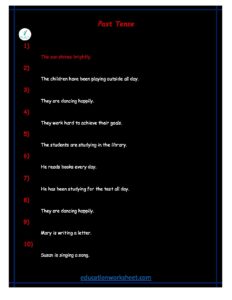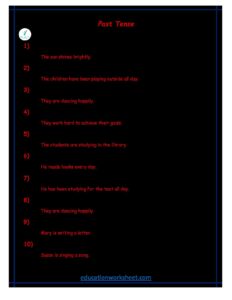how to converting Past Tense positive sentences to interrogative form
how to converting Past Tense positive sentences to interrogative form
Understanding how to convert past tense positive sentences into interrogative form is a fundamental skill in English grammar. Interrogative sentences are used to ask questions and seek information. In this guide, we will explore the various ways to transform statements into questions in the past tense. We’ll cover both regular and irregular verbs, as well as different question forms and examples to illustrate each concept. By the end of this guide, you’ll have a thorough understanding of how to form questions in the past tense.
Basic Structure of Past Tense Interrogative Sentences

In English, past tense interrogative sentences typically follow a specific structure:
[Did + Subject + Base Form of Verb + Rest of the Sentence]?
The “did” in this structure is the auxiliary verb used to form questions in the past tense. The subject is the person or thing performing the action, and the base form of the verb is used. Let’s break down each part of the structure:
- Did: This is the past tense auxiliary verb used to indicate that the sentence is a question in the past tense. It’s the equivalent of “do” in the present tense interrogative sentences.
- Subject: The subject is the person or thing that the question is about. It can be a noun, pronoun, or even a proper noun.
- Base Form of Verb: Unlike positive sentences in the past tense, where verbs are typically conjugated to indicate the past, in interrogative sentences, we use the base form of the verb. This means that most verbs do not change when forming questions in the past tense.
- Rest of the Sentence: This part of the sentence contains the additional information necessary to form a complete question.
Now, let’s delve into the different scenarios for converting past tense positive sentences to interrogative form.
Regular Verbs
Regular verbs follow a predictable pattern when converting positive sentences to questions in the past tense. The base form of regular verbs remains the same, and we introduce “did” to indicate the past tense. Here are some examples:
Positive Sentence: She played tennis yesterday. Interrogative Sentence: Did she play tennis yesterday?
Positive Sentence: They watched a movie last night. Interrogative Sentence: Did they watch a movie last night?
Positive Sentence: He visited his grandparents on the weekend. Interrogative Sentence: Did he visit his grandparents on the weekend?
Notice that in each of these examples, the base form of the verb (play, watch, visit) remains unchanged, and “did” is added at the beginning to indicate the past tense interrogative form.
Irregular Verbs
Irregular verbs, on the other hand, don’t follow a predictable pattern when converting to interrogative sentences in the past tense. The base form of irregular verbs can change, and it’s essential to memorize these changes. Here are some examples:
Positive Sentence: She ate lunch an hour ago. Interrogative Sentence: Did she eat lunch an hour ago?
Positive Sentence: They drove to the beach last summer. Interrogative Sentence: Did they drive to the beach last summer?
Positive Sentence: He flew to Paris last year. Interrogative Sentence: Did he fly to Paris last year?
In these examples, the verbs “eat,” “drive,” and “fly” are irregular, and their base forms change in the past tense. However, the structure of the interrogative sentence remains the same, with “did” added at the beginning.
Negative Past Tense Interrogative Sentences

Converting negative past tense sentences into questions follows a similar structure but with an additional element: the negative form of the verb. Here’s the structure for negative past tense interrogative sentences:
[Did + Subject + Not + Base Form of Verb + Rest of the Sentence]?
Let’s look at some examples:
Negative Sentence: She did not eat lunch an hour ago. Interrogative Sentence: Did she not eat lunch an hour ago?
Negative Sentence: They did not drive to the beach last summer. Interrogative Sentence: Did they not drive to the beach last summer?
Negative Sentence: He did not fly to Paris last year. Interrogative Sentence: Did he not fly to Paris last year?
In these examples, the “not” is placed between “did” and the base form of the verb to create the negative past tense interrogative form. Alternatively, you can use the contraction “didn’t” instead of “did not.”
Using Question Words
In addition to the basic structure, you can also form past tense interrogative sentences using question words (who, what, when, where, why, how). When using question words, the structure of the sentence changes slightly:
[Question Word + Did + Subject + Base Form of Verb + Rest of the Sentence]?
Let’s see how this works with question words:
Positive Sentence: She visited her aunt. Interrogative Sentence: Who did she visit?
Positive Sentence: They went to the park. Interrogative Sentence: Where did they go?
Positive Sentence: He finished the project on time. Interrogative Sentence: How did he finish the project?
In these examples, the question words (who, where, how) are used to introduce the question and provide more context.
Wh-Questions in Past Tense
Wh-questions (questions that begin with question words) can be particularly useful when seeking specific information in past tense interrogative sentences. Here are some common question words and their usage:
- Who: Used to inquire about people.
- Who did she meet yesterday?
- Who was at the party last night?
- What: Used to ask about things or actions.
- What did they buy at the store?
- What happened at the conference?
- When: Used to inquire about time or dates.
- When did he arrive at the airport?
- When did they get married?
- Where: Used to ask about locations or places.
- Where did she find the lost keys?
- Where did they go for their vacation?
- Why: Used to seek reasons or explanations.
- Why did he leave the meeting early?
- Why didn’t they attend the event?
- How: Used to ask about the manner or method of doing something.
- How did she solve the puzzle?
- How did they complete the task so quickly?
Advanced Usage: Tag Questions
Tag questions are another way to create past tense interrogative sentences. They are often used to seek confirmation or clarification and involve adding a short question at the end of a positive statement or negative sentence. The structure of tag questions depends on the main sentence:
- Positive Statement + Negative Tag Question
- You saw the movie, didn’t you?
- She ate lunch, didn’t she?
- Negative Sentence + Positive Tag Question
- They didn’t go to the party, did they?
- He didn’t finish the project, did he?
In tag questions, the tag itself follows the same structure as regular past tense interrogative sentences. You simply add “did” (or “didn’t”) and the base form of the verb to the end of the statement, along with the appropriate subject.
Practice and Common Mistakes
Converting past tense positive sentences to interrogative form is a skill that becomes more natural with practice. Here are some common mistakes to watch out for:
- Incorrect Verb Form: Make sure to use the base form of the verb in the interrogative sentence, not the past tense form used in positive sentences.
Incorrect: Did she played tennis yesterday? Correct: Did she play tennis yesterday?
- Subject-Verb Agreement: Ensure that the subject and verb agree in number (singular or plural).
Incorrect: Did they goes to the store? Correct: Did they go to the store?
- Negation Errors: When converting negative sentences to questions, remember to include “not” or use the contraction “didn’t.”
Incorrect: Did he not finished the task? Correct: Did he not finish the task?
Conclusion
Converting past tense positive sentences to interrogative form is a valuable skill in English grammar. Whether you’re asking about past events, seeking information, or clarifying statements, understanding the structure of past tense interrogative sentences is essential. By following the guidelines presented in this comprehensive guide, you can confidently form questions in the past tense, whether with regular or irregular verbs, negative sentences, or using question words and tag questions. Practice is key to mastering this skill, so keep practicing, and you’ll become proficient in forming past tense interrogative sentences in no time.
how to converting Past Tense positive sentences to interrogative form

how to converting Past Tense positive sentences to interrogative form Discover the simple yet effective techniques for transforming Past Tense positive sentences into interrogative form. Enhance your language proficiency and confidently construct questions in the Past Tense. Unlock a world of clearer communication and linguistic competence now


